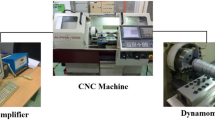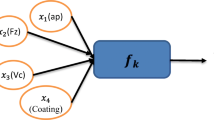Abstract
Today’s metal matrix composites are widely used due to their excellent properties, which are useful for high-performance applications in the automotive and aerospace industries. Furthermore, improving the machinability of these composites is vital for improving product quality in the manufacturing process. In this research, various adaptive network-based fuzzy inference systems (ANFISs) were introduced to evaluate the effect of the feed rate, the cutting speed and the particle size on the machinability of Al–20 Mg2Si metal matrix composite. Two ANFIS models were selected as the most precise models for predicting surface roughness and cutting force. Results show that the proposed ANFIS models have an adequate accuracy in predicting the machinability of metal matrix composites.









Similar content being viewed by others
References
Hwang YK, Lee CM, Park SH (2009) Evaluation of machinability according to the changes in machine tools and cooling lubrication environments and optimization of cutting conditions using Taguchi method. Int J Precis Eng Manuf 10(3):65
Gupta A, Singh H, Aggarwal A (2011) Taguchi-fuzzy multi output optimization (MOO) in high speed CNC turning of AISI P-20 tool steel. Expert Syst Appl 38(6):6822–6828
Palanikumar K, Karthikeyan R (2007) Assessment of factors influencing surface roughness on the machining of Al/SiC particulate composites. Mater Des 28(5):1584–1591
Nur AN, Saeed F, Tuty A, Esah H (2014) Effect of strontium in refining of Mg2Si particulate reinforced Al–20% Mg2Si in situ composite. Am Eurasian J Sustain Agric 8(11):1–5
Farahany S, Ghandvar H, Nordin NA, Ourdjini A, Idris MH (2016) Effect of primary and eutectic Mg2Si crystal modifications on the mechanical properties and sliding wear behaviour of an Al–20Mg2Si–2Cu–xBi composite. J Mater Sci Technol 32(11):1083–1097
Seeman M, Ganesan G, Karthikeyan R, Velayudham A (2010) Study on tool wear and surface roughness in machining of particulate aluminum metal matrix composite-response surface methodology approach. Int J Adv Manuf Technol 48(5–8):613–624
Ozben T, Kilickap E, Cakır O (2008) Investigation of mechanical and machinability properties of SiC particle reinforced Al-MMC. J Mater Process Technol 198(1–3):220–225
Barzani MM, Sarhan AA, Farahany S, Ramesh S, Maher I (2015) Investigating the machinability of Al–Si–Cu cast alloy containing bismuth and antimony using coated carbide insert. Measurement 62:170–178
Barzani MM, Farahany S, Yusof NM, Ourdjini A (2013) The influence of bismuth, antimony, and strontium on microstructure, thermal, and machinability of aluminum-silicon alloy. Mater Manuf Process 28(11):1184–1190
Marani M, Songmene V, Kouam J, Zedan Y (2018) Experimental investigation on microstructure, mechanical properties and dust emission when milling Al–20Mg 2 Si–2Cu metal matrix composite with modifier elements. Int J Adv Manuf Technol 99(1–4):789–802
Zeinali M, Mazlan SA, Fatah AYA, Zamzuri H (2013) A phenomenological dynamic model of a magnetorheological damper using a neuro-fuzzy system. Smart Mater Struct 22(12):125013
Khanlou HM, Ang BC, Barzani MM, Silakhori M, Talebian S (2015) Prediction and characterization of surface roughness using sandblasting and acid etching process on new non-toxic titanium biomaterial: adaptive-network-based fuzzy inference System. Neural Comput Appl 26(7):1751–1761
Pourtousi M, Zeinali M, Ganesan P, Sahu JN (2015) Prediction of multiphase flow pattern inside a 3D bubble column reactor using a combination of CFD and ANFIS. Rsc Adv 5(104):85652–85672
Dong M, Wang N (2011) Adaptive network-based fuzzy inference system with leave-one-out cross-validation approach for prediction of surface roughness. Appl Math Model 35(3):1024–1035
Ho WH, Tsai JT, Lin BT, Chou JH (2009) Adaptive network-based fuzzy inference system for prediction of surface roughness in end milling process using hybrid Taguchi-genetic learning algorithm. Expert Syst Appl 36(2):3216–3222
Çaydaş U, Hasçalık A, Ekici S (2009) An adaptive neuro-fuzzy inference system (ANFIS) model for wire-EDM. Expert Syst Appl 36(3):6135–6139
Maher I, Sarhan AA, Barzani MM, Hamdi M (2015) Increasing the productivity of the wire-cut electrical discharge machine associated with sustainable production. J Clean Prod 108:247–255
Barzani MM, Zalnezhad E, Sarhan AA, Farahany S, Ramesh S (2015) Fuzzy logic based model for predicting surface roughness of machined Al–Si–Cu–Fe die casting alloy using different additives-turning. Measurement 61:150–161
Salur E, Aslan A, Kuntoglu M, Gunes A, Sahin OS (2019) Experimental study and analysis of machinability characteristics of metal matrix composites during drilling. Compos Part B Eng 166:401–413
Bai W, Roy A, Sun R, Silberschmidt VV (2019) Enhanced machinability of SiC-reinforced metal-matrix composite with hybrid turning. J Mater Process Technol 268:149–161
Azwadi CSN, Zeinali M, Safdari A, Kazemi A (2013) Adaptive-network-based fuzzy inference system analysis to predict the temperature and flow fields in a lid-driven cavity. Numer Heat Transf Part A Appl 63(12):906–920
Nordin NA, Farahany S, Abubakar T, Hamzah E (2015) Alteration by cerium element on primary and eutectic Mg2Si phases in Al–20% Mg2Si in situ composite. Adv Mater Res 1125:23
Rath D, Panda S, Pal K (2018) Prediction of surface quality using chip morphology with nodal temperature signatures in hard turning of AISI D3 steel. Mater Today Proc 5(5):12368–12375
Kannan S, Kishawy HA (2008) Tribological aspects of machining aluminum metal matrix composites. J Mater Process Technol 198(1–3):399–406
Barzani MM, Farahany S, Songmene V (2017) Machinability characteristics, thermal and mechanical properties of Al–Mg2Si in situ composite with bismuth. Measurement 110:263–274
Author information
Authors and Affiliations
Corresponding author
Additional information
Publisher's Note
Springer Nature remains neutral with regard to jurisdictional claims in published maps and institutional affiliations.
Rights and permissions
About this article
Cite this article
Marani, M., Songmene, V., Zeinali, M. et al. Neuro-fuzzy predictive model for surface roughness and cutting force of machined Al–20 Mg2Si–2Cu metal matrix composite using additives. Neural Comput & Applic 32, 8115–8126 (2020). https://doi.org/10.1007/s00521-019-04314-6
Received:
Accepted:
Published:
Issue Date:
DOI: https://doi.org/10.1007/s00521-019-04314-6




